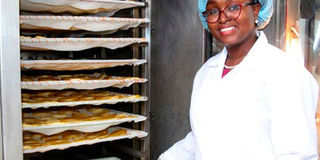Prime
You can do so much with fruits for more value

A farmer displays her modern fruit drier. Photo | NMG
What you need to know:
- Majority of farmers sell their produce either on the farm or through local markets, exposing themselves to exploitation by middlemen due to perishability. But such losses can be minimised if farmers embraced value addition.
A value chain is a set of linked activities that work to add value to a product; it consists of actors and actions that improve a product while linking commodity producers to processors and markets.
Lillian Linda, a communication specialist at Uganda Industrial Research institute (UIRI), a government parastatal that focuses on promoting technological advancement in Uganda’s growing industry, says there is a need to exploit human capital and technology to increase product shelf-life and enhance innovations.
She says, “Agriculture is considered as the country’s backbone and there is so much it has to offer. The harvests can still fetch long-term gains in mass production during peak time when supply is higher.”
This she suggests is achieved through offering trainings and guidance for people in mass production and in this way setting a base for skilled and knowledgeable producers.
According to Ruth Nakazibwe, a laboratory technician in the food processing department at UIRI, the shelf life of fruits and vegetables is subject to incubation.
Here the food expert takes us through the process in which these perishables are kept at right temperatures and under the right conditions in order to increase market demands regardless of the season.
Tomatoes
Today, consumers demand food products, which are nutritious as well as convenient to use. Tomato powder is usually ready at a consumers’ disposal but also has nutritional benefits.
According to Nakazibwe, tomato powder is made by drying tomatoes and then grinding them into a fine powder. “You peel off the tomato skins, without the pulpy interior with seeds to achieve a food powder,” she shares.
Sandra Nabasirye, a young farmer, has profound interest in tomato farming.
She says this being the main crop grown on her farm she is challenged to identify better preservation methods rather than having them at a giveaway price.
“I realised my tomato harvests were struggling on market due to the high prices that came with a shift in the unfavourable weather conditions and acquired prompt knowledge from a colleague in making tomato powder,” she says.
To start, Nabasirye had a trial of 200 kilogrammes equivalent to a box of tomatoes to make powder, which she used a local procedure to slice the tomatoes and expose them in direct sun under a shade to dry.
“I was able to recover only two kilogrammes of food powder and carried the products into a testing time frame of about two months for their longevity,” says Nabasirye. The food expert emphasizes good storage mechanisms for food powder.
“The powder needs to be kept in a cool and dry place in your pantry together with other dried spices,” she says.
Cucumber
Nabasirye also explores a number of marketing skills for products by making them accessible to the market. She says cucumber is highly nutritious and can be sold to massage parlours or cosmetic companies for enriched skin products.
“If my customers can’t reach me, I am sure to reach them through my door to door delivery which has also increased on my sales,” she says.
The young farmer hires a van to transport vegetables from her farm in Nabbingo to the consumers.
“I move to offices, and different homes or properties to find a market base. I am sometimes constrained by high fuel prices and long distances to identified markets which surely affects my sales,” she laments.
To mitigate some of these unavoidable challenges, Nabasirye ensures to gather multiple orders to be able to cut on cost. She also shares her tip on roadside sales where she gets to access walk-in clients without incurring fuel costs.
Mangoes, watermelon, pineapple
Linda categorically places fruit extracts for juice to be highly nutritional. She says, “Unlike the quencher and powdered juices that are completely chemical concentrates, the natural fruit juices are predominantly fruit with limited preservatives designed to add a shelf life to them.”
According to Nakazibwe, mass production for fruit extracts requires blending fruits together which involves a chain of machinery.
“A full processing line is likely to cost about Shs800m. This entails a fruit pulpier at Shs100m for crushing fruits without water additives leaving the product thick, a homogenizer that mixes product to uniformity hence preventing separation, a pasteurizer that gives product heat treatment, a holding tank and filling unit to complete the chain,” she elaborates.
The food expert also regards the costing that comes with packaging. She notably distinguishes the tinned and vacuum seals on product to be of great consideration as the latter is more costly but elongates a shelf life of product without heavy preservatives.
“The imported tins are priced at Shs1,500 each whereas the vacuum seals come in a roll of plastics and this can cost Shs10,000 or Shs20,000 per kilogramme.”
Sugarcane
The sugarcane bagasse is a raw material among others used in the paper making industry as recommended by Linda.
She says these off throws from consuming the fruit are essential in supporting the campaign against contaminating the soil with hazardous wastes such as polythene bags.
“Through paper making, the sugarcane bagasse together with the banana stem residue creates a concentrate where cotton rugs are thrown therein to soften the end product hence creating an innovation of gift bags, cake boxes and paper bags,” she adds.
Tom Zirimenya, a proprietor at Natural Crafted Blends, a sugarcane juice processing company says the fruit is of great venture.
“I started juice production during my senior six vacation and we had to jointly invest in machinery which cost us about Shs1m for manual equipment,” says Zirimenya. To tackle the issue of scarcity, the Zirimenya does not cling to one supplier.
“We have different suppliers just in case one has run low on the fruit availability. In this way we ensure continuous productivity except for the high transportation costs incurred while making the raw-material accessible and available,” he says.
The juice maker includes natural preservatives such as lemon, ginger, and mint to add a shelf life to the product which he says works best with good storage mechanisms of improvising a refrigerator.





